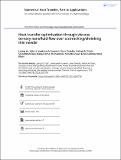Files in this item
Heat transfer optimisation through viscous ternary nanofluid flow over a stretching/shrinking thin needle
Item metadata
| dc.contributor.author | Yu, Liping | |
| dc.contributor.author | Li, Yijie | |
| dc.contributor.author | Puneeth, Venkatesh | |
| dc.contributor.author | Znaidia, Sami | |
| dc.contributor.author | Shah, Nehad Ali | |
| dc.contributor.author | Manjunatha, Sarpabhushana | |
| dc.contributor.author | Anwar, Muhammad Shoaib | |
| dc.contributor.author | Khan, Muhammad Riaz | |
| dc.date.accessioned | 2023-11-14T09:30:06Z | |
| dc.date.available | 2023-11-14T09:30:06Z | |
| dc.date.issued | 2023-10-26 | |
| dc.identifier | 294216757 | |
| dc.identifier | 3169f515-0ded-476b-9d6b-cb56dc61afb7 | |
| dc.identifier | 85174838444 | |
| dc.identifier.citation | Yu , L , Li , Y , Puneeth , V , Znaidia , S , Shah , N A , Manjunatha , S , Anwar , M S & Khan , M R 2023 , ' Heat transfer optimisation through viscous ternary nanofluid flow over a stretching/shrinking thin needle ' , Numerical Heat Transfer, Part A: Applications , vol. Latest Articles . https://doi.org/10.1080/10407782.2023.2267750 | en |
| dc.identifier.issn | 1040-7782 | |
| dc.identifier.uri | https://hdl.handle.net/10023/28687 | |
| dc.description | The authors extend their appreciation to the Deanship of Scientific Research at King Khalid University for funding this work through large group Research Project Project under the grant number RGP2/107/44. | en |
| dc.description.abstract | The current investigation interprets the flow and the thermal characteristics of the ternary nanofluid composed of MoS2, ZnO, and SiO2 spherical nanoparticles and water. The resulting nanofluid is MoS2−ZnO−SiO2−(H2O+EG) where (H2O+EG) act as the base fluid which help in the flow and the nanoparticles contribute to enhancing the heat conductivity. The flow is assumed to occur across a thin needle whose surface is maintained at a higher temperature than the surroundings. The mathematical model is framed by incorporating radiation introduced by Rosseland in terms of partial differential equations (PDE). This system of equations governs the flow and thermal properties of fluid which are converted to a system of ordinary differential equations (ODE). The major outcomes of the study indicated that the increase in the amount of molybdenum disulfide enhanced the heat conducted by the nanofluid whereas it reduced the flow speed. The positive values of the heat source/sink parameter caused the heat conduction of the nanofluid to go high. | |
| dc.format.extent | 15 | |
| dc.format.extent | 1400670 | |
| dc.language.iso | eng | |
| dc.relation.ispartof | Numerical Heat Transfer, Part A: Applications | en |
| dc.subject | Heat transfer | en |
| dc.subject | Nanoparticles | en |
| dc.subject | Radiation | en |
| dc.subject | Slip | en |
| dc.subject | Ternary nanofluid | en |
| dc.subject | QC Physics | en |
| dc.subject | T-NDAS | en |
| dc.subject | NIS | en |
| dc.subject.lcc | QC | en |
| dc.title | Heat transfer optimisation through viscous ternary nanofluid flow over a stretching/shrinking thin needle | en |
| dc.type | Journal article | en |
| dc.contributor.institution | University of St Andrews. School of Computer Science | en |
| dc.identifier.doi | 10.1080/10407782.2023.2267750 | |
| dc.description.status | Peer reviewed | en |
This item appears in the following Collection(s)
Items in the St Andrews Research Repository are protected by copyright, with all rights reserved, unless otherwise indicated.

